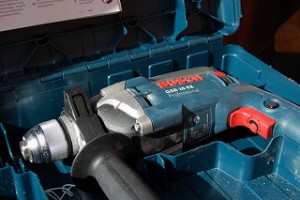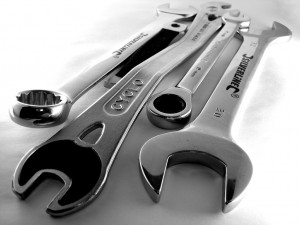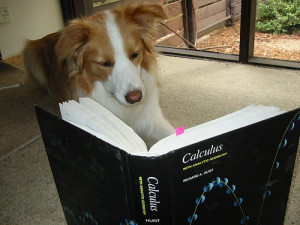Podcast: Play in new window | Download
Subscribe: Apple Podcasts |
 Adam, Brian, Carmen and Jeff discuss tools they use for utility and enjoyment at home, where the cost-to-quality evaluation is slightly different than in the workplace.
Adam, Brian, Carmen and Jeff discuss tools they use for utility and enjoyment at home, where the cost-to-quality evaluation is slightly different than in the workplace.
- Jeff’s collection of tools is rather ancient, as suggested by his 35 year old corded Craftsman drill, and his 20 year old cordless Mikata drill with rapidly fading batteries.
- Going to big box stores (Home Depot, Lowe’s, etc.) a week or two after Black Friday is Brian’s suggestion for getting tools at a good price.
- A hot air gun is useful for stripping paint, melting solder, constricting heat shrink, thawing ice, and bending plastic sheet.
- Brian’s friend successfully removed 150 year old paint using a heat gun and a 5-in-1 painter’s tool.
- It’s hard to beat the utility of locking pliers, better known as Vice-Grips.
- While Jeff finds his Dremel rotary tool to be extremely practical, Brian has only succeeded in using his to “wreck” projects.
- A router table accessory has increased the usefulness of Adam’s Dremel tool.
- For larger scale projects, Brian and Adam find their angle grinders make short work of cutting and grinding tasks.
- Carmen built his workbench using the 2×4 Basics system by Hopkins Manufacturing.
- Butcher block countertops can be found at IKEA, although they are also available from other sources.
- Many common tools can be found at Harbor Freight, Northern Tool, and Tractor Supply.
- Supposedly, the average electrical drill is only used for a few minutes over its lifetime, although a valid study citation seems hard to locate.
- Carmen is happy with his Harbor Freight Big Red tool chest, which is said to deliver good bang for the buck.
- Adam Savage’s first order retrievability metric has led him to develop some very innovative toolboxes.
- You can compare your desk layout with that of others in the Workbenches and Battlestations reddits.
- Carmen alerts us to some well-considered workbench tips from Jeff Duntemann.
- An impact driver has proven a useful tool for Carmen and Brian. Versions from Milwaukee and Craftsman are mentioned.
- Although Brian believes no shop is complete without a Bridgeport mill, Jeff notes any big piece of equipment must be used regularly to balance the accompanying maintenance and opportunity costs.
- Adam opines that one’s first drill purchase should be a corded drill, as it is not subject to changes in battery technology.
- Rigol oscilloscopes are plenty good, say Brian and Carmen, for most home electronics projects.
- Some improvements can be made to the Rigol scopes, however, if one has a sense of adventure.
- A digital multi-meter (DMM) is a useful for troubleshooting most household electrical problems.
- Common communication protocols for microcontroller-level devices include Serial Peripheral Interface (SPI) and Inter-Integrated Circuit (I2C), or “I-squared C.”
- The Digilent Analog Discovery USB Oscilloscope is recommended by Carmen as being one of the better USB scopes. This model has also been reviewed on EEVblog by Dave Jones.
- A ball-grid array (BGA) surface mount device uses small spheres on the bottom of the device to make electrical connections with the circuit board.
- Brian has had good luck with low-temperature solder paste, available from Digi-Key.
- Reciprocating saws, often referred to by the trade name Sawzall, have been put to good use by Adam and Jeff.
Thanks to Mark Hunter for the photo titled “Bosch GSB 16 RE Impact Drill.” Podcast theme music by Paul Stevenson.
Podcast: Play in new window | Download
Subscribe: Apple Podcasts |
 This episode centers on tools that we enjoy using, whether engineering-related or not.
This episode centers on tools that we enjoy using, whether engineering-related or not.
- Jeff is of the opinion that many engineering professors dislike teaching “tools” because software packages are constantly changing in scope and syntax, and associated teaching materials must be vigilantly updated.
- Reliability is an important characteristic for a good engineering tool, according to Carmen and Adam.
- Brian notes the economic foolishness of having an engineer “spin their wheels” due to a lack of quality tools.
- Chip-scale packages (CSPs) are mentioned by Carmen as a new technology requiring new tools.
- Brian asks about the need for traceability on tools (governed by NIST standards in the United States).
- Several communication protocols are mentioned in discussion of oscilloscope features: SPI, CAN, and I2C.
- We determine that Bridgeport Machines was acquired by a multinational corporation (Hardinge, Inc.) in 2004.
- Adam reveals that transportation departments establish contingency contracts to ensure access to big construction equipment in emergency situations.
- We learn about Ball Grid Arrays (BGA) from Carmen.
- Brian and Carmen converse about the best wire gage (AWG) for their soldering needs.
- The Pragmatic Podcast episode about coffee, produced by former TEC guest John Chidgey, is mentioned as a “must listen” for avid coffee drinkers.
- Emissivity is an important issue for those using infrared temperature detection.
- Mechanical pencil fans can find plenty of websites dedicated to the subject.
- Jeff’s tools:
- Adam’s tools:
- Carmen’s tools:
- Brian’s tools:
Thanks to J for use of the image titled “Tools.” Podcast theme music by Paul Stevenson.
Podcast: Play in new window | Download
Subscribe: Apple Podcasts |
 In this episode, Adam, Carmen and Jeff talk about engineering skills, and where they are obtained.
In this episode, Adam, Carmen and Jeff talk about engineering skills, and where they are obtained.
- Adam has used “soft” skills more than “hard” skills thus far in his engineering career.
- On the other hand, Carmen makes heavy use, at least on occasion, of the “hard” skills he learned in his engineering education.
- Adam notes that the ABET criteria for civil engineering requires a focus on the areas of management, business, policy, and leadership not required by other engineering fields.
- Jeff highlights a presentation by Richard Miller, the president of Olin College, that discusses the challenge of balancing hard and soft skills in the engineering curriculum.
- A thesis by Kristen Wolfe discuses the skills that mechanical engineers from MIT use five years after graduation, which tended to be more collaborative than technical.
- Conflict with co-workers seems to be a common reason for dismissal, so hiring firms are spending more time checking the collaborative skills of potential employees.
- In accessing soft skills at career fairs, Carmen finds that many engineering graduates have trouble presenting themselves in a professional manner.
- Carmen got better at interviewing by going on multiple interviews; a case of practice makes perfect? He aspires to be like Jim Williams and Bob Pease.
- Adam and Carmen offer suggestions for improving one’s social skills, mainly by getting into situations where you have to deal with others on a regular basis.
- Schools should focus on the hard skills, Carmen claims, because engineering students can pick up the soft skills elsewhere.
- Jeff asks whether an engineering education should be “just in case” or “just in time.”
- Some research indicates that a minority of engineering graduates remain in science and engineering five years after graduation.
- Adam was rewarded in his school work for recognizing when an answer was incorrect.
- Carmen and Adam both felt like they benefited greatly from participating in co-op programs.
- Where are engineering graduates supposed to learn “tools,” such as CAD systems, or simulation software? There’s no clear answer, but many employers expect their new hires to have experience with specific software packages.
- We may be entering an age of hyperspecialization (PDF of article from Harvard Business Review.)
.
Thanks to Dean Jackson for the photo titled “NooNoo studying calculus.” Podcast theme music provided by Paul Stevenson
Practical insights for the engineering crowd
 Adam, Brian, Carmen and Jeff discuss tools they use for utility and enjoyment at home, where the cost-to-quality evaluation is slightly different than in the workplace.
Adam, Brian, Carmen and Jeff discuss tools they use for utility and enjoyment at home, where the cost-to-quality evaluation is slightly different than in the workplace.
